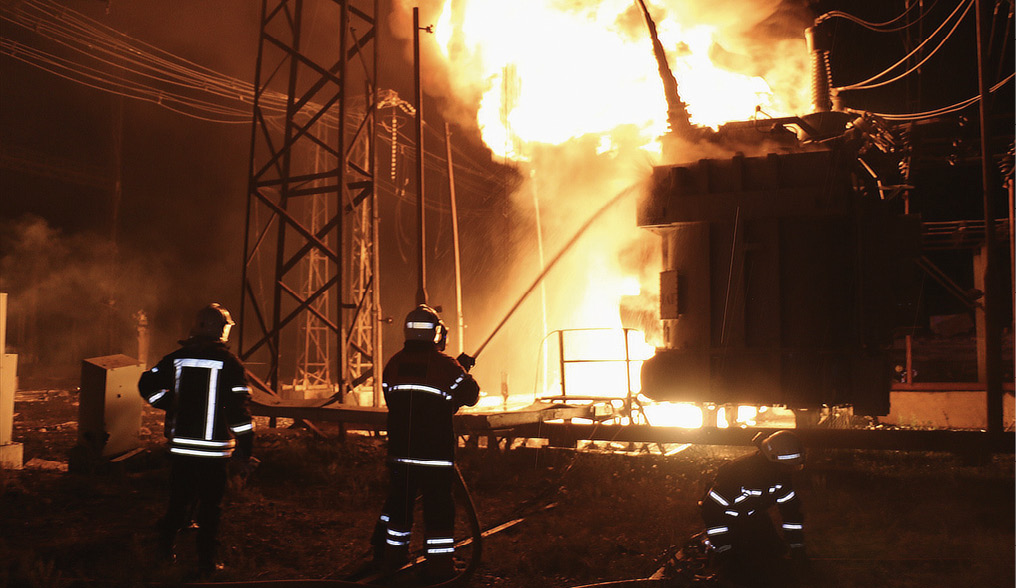In 2012, as a board member of the Association of Alternative Fuel and Energy Market Participants of Ukraine, I took part in a meeting of renewables companies with the leadership of energy regulator the National Commission for State Regulation of Energy and Utilities. The main topic was the development of home solar in Ukraine.

Image: IB Centre
The regulator was not receptive. Our decentralization arguments were met with skepticism, to put it mildly, by representatives of the old Soviet centralized power generation system. One of the commission members said the idea home solar could be a useful market segment was delusional, therefore there was no point developing it.
Exactly 10 years later, home solar arrays became almost the only source of energy for Ukrainians left without electricity due to the centralized energy infrastructure destroyed by Russian missiles and bombs.
As the world becomes increasingly reliant on technology and digital systems, the need for secure and reliable energy becomes ever more pressing. While traditional, fossil fuel-based systems have long been the mainstay of global energy, growing awareness of their negative environmental impact, the finite nature of such resources, and the rising potential for geopolitical conflict has prompted a renewed focus on decentralized, renewable energy systems.
Obvious targets
Ukraine has become a vivid example of how the centralization and monopolization of an energy system can lead to tragic political, environmental, and economic consequences. The nation's chronic dependence on Russian energy sources, in particular, oil, gas, and nuclear fuel, created the prerequisites for almost 100% Russian control over the Ukrainian economy. A similar situation has developed in many European countries.
After more than a decade of advocating for the decentralization of Ukraine's energy system, I was pleased to see president Volodymyr Zelensky declare the such an aim will be a state priority. It is essential that governments and private sector actors prioritize the development and deployment of decentralized renewable energy systems in order to ensure a secure and sustainable energy future. Action must not be blocked by fossil fuel energy lobbyists or short-sighted thinking. In Ukraine, for example, the development of decentralized renewable energy systems has been held up for over a decade by various energy lobbies, including the Russian nuclear industry. As a result, only 70,000 households have been able to benefit from the security and resilience of decentralized systems, rather than the millions that could have done so.
Warnings
Energy dependence has created very dangerous conditions for military aggression. In 2014, my consultancy and cleantech thinktank the Innovative Business Centre (IB Centre), together with former German Green Party MP Hans-Josef Fell, organized the EuroSEF 2014 event in Brussels. The energy security forum saw industry experts and members of the European Parliament discuss the new energy configuration of Europe in the context of dependence on Russia. Unfortunately, not everyone understood the scale of the threat then.
The leadership of Russia, the largest supplier of energy carriers to the countries of the European Union, expected that during its invasion of Ukraine, Europe would pretend the war did not concern them and would instead choose economic stability based on Russian gas, oil, and nuclear fuel. We cannot say all European countries passed this test.
What is the solution in such a situation? Diversification of energy supply and decentralization. Furthermore, decentralization also holds paramount strategic significance.
A centralized system is an easy target for cruise missiles. In the case of Ukraine last year, the Russian military purposely destroyed the country's energy system by bombing transformers, leading to widespread blackouts. Ukrainian households and companies that had installed autonomous renewable energy systems, such as solar panels and biofuel heating and electricity systems, were able to continue to have access to electricity and heating, demonstrating the inherent resilience and security of decentralized systems.
In 2011, the IB Centre started a pilot project within the framework of the Ukrainian Association of Renewable Energy. We decided to lobby for the opening up of the solar energy market to households.
The renewable energy association was the first such body in the Ukrainian cleantech industry, which at that time united more than 75% of players in the clean energy market. We communicated the aims of our project through the resources of the IB Centre, which at that time managed the leading new energy industry information platform, had its own news agency, and produced industry publications from the cleantech sector.
We immediately found ourselves at the epicenter of lively discussion, which mainly centered on the fact that representatives of legacy energy systems were inventing reasons why individuals could not become solar energy generators. Those disputes continued until 2015, when the Ukrainian parliament finally adopted amendments to a law enabling a green tariff for individuals – homeowners.
Trigger for change
The war in Ukraine became the trigger for radical change in the European energy paradigm. Today, most of the countries of Central Europe and Eastern Europe quickly adopt legislative changes aimed at the development of decentralization of energy, in particular solar energy, without too much delay and prevarication.
A great example of a rapid pivot to green, decentralized energy is Romania. In July, the country’s Ministry of Energy announced a finance program for solar arrays on social infrastructure facilities that is worth more than €500 million ($535 million). At the beginning of this month, the Ministry of Agrarian Policy of Romania announced the launch of a finance package for solar panels for farmers worth almost €1 billion. A little earlier, Romania had already announced an intent to install 160,000 solar roofs in the next two years.
That is why we have chosen Bucharest as the venue for CISOLAR 2023, the 11th Solar Energy Conference and Trade Show of Central and Eastern Europe, which will take place in the Romanian capital on Oct. 30-31. We want to write a new page of energy transformation in the region and demonstrate that even the most centralized systems in Europe can be transformed into green, decentralized ones with the help of solar energy. After all, there are simply no other options for the evolution of our energy systems.
About the author: Julia Daviy-Berezovska is co-founder of US-based organizations the IB Centre and the Sustainable Innovations Council. She has received worldwide recognition as a pioneer in technology for sustainability and a leading advocate for the progression of clean technology in developing economies. Julia was instrumental in liberalizing Ukraine's solar energy sector for independent organizations and private households.
The views and opinions expressed in this article are the author’s own, and do not necessarily reflect those held by pv magazine.
This content is protected by copyright and may not be reused. If you want to cooperate with us and would like to reuse some of our content, please contact: editors@pv-magazine.com.



Orchard Partners London have proposed 500 kW packaged CHP units at MV/LV substations for District Heating DH and electricity backup in the UK eg 20,000 installations at most 11kV to 415 volt transformers. They could have clutched flywheel (frequency stabilizsation) + clutched mechanical heat pump (DH) + excess elec resistance heat dump to DH in a smart grid (excess local PV/renewable generation) . The existing LP gas main could be repurposed as DH return ) + LV elec grid reinforcement + fibre optic) the way leave would also be used for DH supply. The local electrical grid reinforcement and excess RE dump could avoid LV wiring /transformer upgrade particularly for EVs. They could operate to peak shave heat /power and during Dunkelflaute periods.
The CHP could be connected to the MP Medium Pressure gas/hydrogen network that would probably be retained for hard to electralise industry. Alternatively a modest bio-fuel/gas store sized for Dunkelflaute peroids could be provide eg ~35,000 litres /10 days at full load. Whilst an additional cost to lower cost central RE plant it would give some degree of local grid resilience.